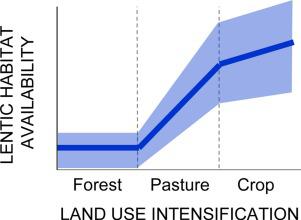Perspectives in Ecology and Conservation ( IF 4.7 ) Pub Date : 2020-06-23 , DOI: 10.1016/j.pecon.2020.05.001 Luis Schiesari , Paulo R. Ilha , Daniel Din Betin Negri , Paulo Inácio Prado , Britta Grillitsch

|
Hydrological change is a conspicuous signal of land use intensification in human-dominated landscapes. We hypothesized that land conversion and land use change increase the availability of lentic habitats and associated biodiversity in Southern Amazonian landscapes through at least four drivers. River damming promotes the formation of reservoirs, which are novel permanent lentic water bodies. A rise in the water table driven by local deforestation promotes the expansion of shallow riparian floodplains. Soil compaction and the deliberate construction of cattle and drainage ponds promote the increase in temporary water bodies in interfluves. We tested these hypotheses using data on habitat characterization and biological surveys of amphibians and fish in forests, pastures and soybean fields in the headwaters of the Xingu River in Mato Grosso, Brazil. Lentic habitat availability sharply increased in deforested land, with consequences to freshwater biodiversity. Reservoir formation influenced both fish and amphibian assemblage structure. Fish species ranged from strongly favored to strongly disfavored by reservoir conditions. Amphibian richness and abundance increased in pasture and soybean streams relative to forests in proportion to the density of reservoirs in the landscape. Expansion of stream floodplains increased the abundance of Melanorivulus megaroni, a fish species indicator of shallow lentic habitats. Rainwater accumulation in temporary ponds and puddles, absent from well-drained forested interfluves, allowed the invasion of converted interfluves by twelve species of open-area amphibians. A literature review indicates that these four drivers of hydrological change are geographically widespread suggesting that we may be witnessing a major yet previously unaccounted form of habitat change in deforested Amazonia, affecting both biodiversity and human health.
中文翻译:

新姑盆地上游的池塘,水坑,洪泛区和水坝:我们能否目睹森林砍伐的亚马逊地区的“集约化”?
水文变化是人为主导景观中土地利用集约化的明显信号。我们假设,土地转化和土地利用变化至少可以通过四个驱动因素来提高南亚马逊地区景观中的透镜状生境和相关生物多样性的可用性。河流筑坝促进了水库的形成,水库是新型的永久性胶状水体。由当地森林砍伐导致的地下水位上升促进了浅滩河滩泛滥。土壤压实和蓄意修建牛和排水塘促进了沟渠中临时水体的增加。我们使用了巴西马托格罗索州新古河上游森林,牧场和大豆田中的两栖动物和鱼类的栖息地特征数据和生物学调查数据,对这些假设进行了检验。在森林砍伐的土地上,扁豆栖息地的可用性急剧增加,对淡水生物多样性产生了影响。水库的形成影响了鱼类和两栖动物的组合结构。受水库条件影响,鱼类种类从强烈偏爱到严重不等。与森林相比,牧场和大豆流中的两栖动物丰富度和丰度与景观中水库的密度成正比。溪流泛滥区的扩张增加了河滩的丰度 与森林相比,牧场和大豆流中的两栖动物丰富度和丰度与景观中水库的密度成正比。溪流泛滥区的扩张增加了河滩的丰度 与森林相比,牧场和大豆流中的两栖动物丰富度和丰度与景观中水库的密度成正比。溪流泛滥区的扩张增加了河滩的丰度Melanorivulus megaroni,一种浅的透镜状生境的鱼类指标。排水良好的林间插穗不存在临时池和水坑中的雨水积聚,使转化的插穗被十二种开阔地两栖动物入侵。文献综述表明,这四个水文变化驱动因素在地理上是广泛分布的,这表明我们可能正在目睹森林砍伐的亚马逊地区生境变化的一种主要但以前无法解释的形式,影响生物多样性和人类健康。


























 京公网安备 11010802027423号
京公网安备 11010802027423号